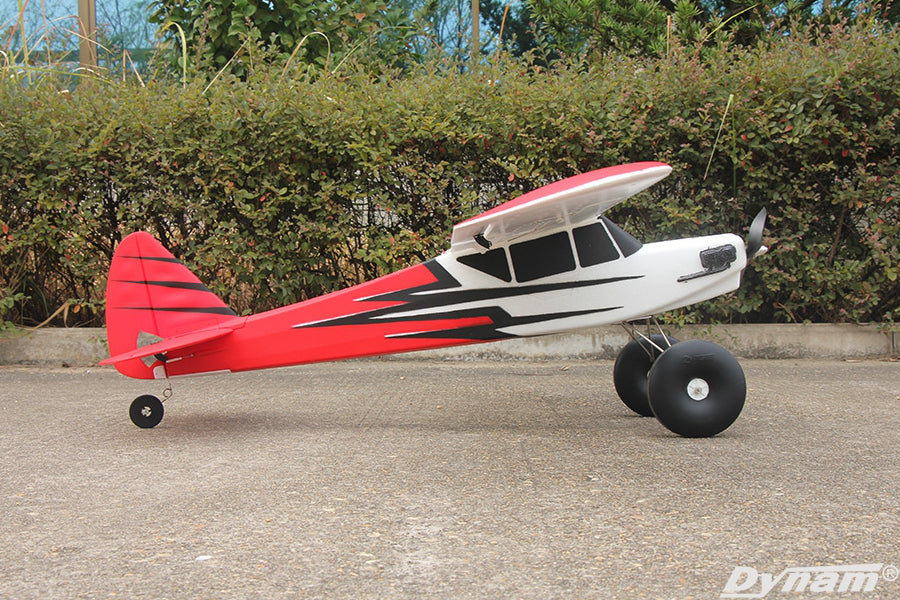Flying a remote-controlled (RC) plane can be a thrilling experience, but when the wind picks up, it can make the flight challenging—even for experienced pilots. Windy conditions can turn a smooth flight into a struggle to maintain control, leading to frustration and even damage to your RC plane. As someone who’s been in the RC flying hobby for years and regularly flies models like the Dynam Primo RC Beginner Trainer Red STOL Bigfoot 4S 1450mm with flaps, I understand how tricky it can be to manage stability in the wind. In this article, I’ll share practical strategies for improving the stability of your RC planes in windy conditions, along with tips from my personal experience.
Why Wind Affects RC Planes
Wind introduces turbulence that can destabilize an RC plane, especially if it’s light or has a smaller wingspan. The two main factors that influence your plane’s stability are wind speed and wind direction. When the wind direction changes rapidly, it can cause unpredictable movements that are hard to compensate for. Additionally, strong gusts or crosswinds can push your plane off course, demanding quick reflexes and precise control inputs.
1. Choose the Right RC Plane for Windy Conditions
The first step in ensuring stability in windy conditions is selecting the right plane. As a beginner or intermediate pilot, you’ll want a model that can handle gusty winds without losing control.
My personal recommendation, based on my experience with the Dynam Primo RC Beginner Trainer, is to choose planes with a larger wingspan, low wing loading, and high stability characteristics. The Dynam Primo, for instance, has a relatively large wingspan of 1450mm, making it more stable in windy conditions compared to smaller, lightweight models. Planes with high wing loading (weight-to-wing surface ratio) are often more stable because their heavier mass resists sudden gusts.
2. Adjust Your Control Surfaces for Better Handling
The control surfaces (elevator, ailerons, rudder) of your RC plane play a crucial role in how well your plane handles turbulence. For windy conditions, making subtle adjustments to these surfaces can enhance stability.
- Ailerons: Increase aileron deflection slightly to improve roll control in gusty conditions. This will help keep the plane level during crosswind maneuvers.
- Elevator: Adjust the elevator trim to ensure that the plane maintains level flight without requiring constant input from the pilot.
- Rudder: The rudder is particularly important in crosswinds. If the plane is frequently getting pushed sideways, a small increase in rudder deflection can help.
It’s worth noting that excessive control surface movement can worsen instability, so be sure to make gradual adjustments and test the effect during your flight.
3. Use Flight Stabilization Systems
If you’re flying in extremely windy conditions or you just want an extra layer of security, flight stabilization systems can make a world of difference. These systems often come built into newer RC planes or can be added as a separate unit.
For example, many newer models, including the Dynam Primo, come with built-in Gyros that automatically adjust the plane’s control surfaces to minimize instability. This helps the plane maintain a steady flight path even when faced with wind gusts. If your plane doesn’t have built-in stabilization, you can install an aftermarket flight controller with stabilization features like Z3 gyros or GPS-based stabilization.
4. Master Your Flying Technique
Your flying technique is just as important as the hardware in windy conditions. The way you control your plane can either exacerbate or alleviate the effects of wind.
Tips for Flying in Windy Conditions:
- Fly into the wind: Always approach your landing or takeoff into the wind. This gives you greater control and a shorter landing distance.
- Avoid rapid control inputs: In windy conditions, sudden movements can cause the plane to overreact. Instead, make smooth, gradual inputs.
- Increase your altitude: Wind turbulence is often more pronounced closer to the ground. Flying higher can help you avoid the worst of the gusts.
- Anticipate gusts: When flying in gusty winds, always be ready to make quick adjustments. A sudden gust can push your plane off course unexpectedly, so stay alert and ready to correct quickly.
- Plan for a go-around: If your approach is too turbulent for a safe landing, don’t hesitate to pull up and go around. It’s better to try another approach than to risk a rough landing in gusty winds.
5. Trim and Balance Your RC Plane
Having your plane properly trimmed and balanced is critical for stability in any flying condition, but it’s especially important in windy weather. Here’s what to focus on:
- Trim for level flight: Ensure that your plane is trimmed to fly level without needing constant control inputs.
- Balance the plane correctly: The center of gravity (CG) should be at the manufacturer’s recommended point. If the CG is too far forward or backward, it will affect the plane’s handling. A plane with the wrong balance will be harder to control, especially in turbulent air.
6. Choose the Right Propeller
The propeller you choose can influence how your plane handles the wind. A larger propeller will give more thrust and can help the plane climb faster, which is useful when trying to avoid turbulent air near the ground. However, a smaller propeller can reduce drag and give you better overall control in windy conditions, especially for flying at lower speeds.
7. Plan for Wind Gusts and Changing Conditions
Always check the weather forecast before heading out to fly. Wind speed and gusts can change quickly, and it’s important to understand what conditions you’ll be flying in. Ideally, avoid flying in winds stronger than 15-20 mph, as this can make it difficult to control the plane, especially for beginners. Also, keep an eye on any wind shear, where wind speeds vary significantly with altitude, which can cause unpredictable changes in the plane’s behavior.
FAQ Section
Q: What’s the best RC plane for beginners to fly in windy conditions?
A: The Dynam Primo RC Beginner Trainer Red STOL Bigfoot 4S is a great option due to its large wingspan (1450mm), stability, and low wing loading. It’s easier to control in wind compared to smaller planes, making it a solid choice for beginners.
Q: How do I know if my RC plane is balanced correctly?
A: A properly balanced plane should fly level with minimal control input. Check the manufacturer’s recommended center of gravity (CG) and adjust by moving the battery or adding weight as needed.
Q: Can a flight stabilizer help in windy conditions?
A: Yes, flight stabilizers help smooth out the effects of wind by automatically adjusting the plane’s control surfaces. This can greatly enhance stability and make flying in gusty conditions easier.
Q: What’s the maximum wind speed for safe flying?
A: For beginners and intermediate pilots, I recommend avoiding winds over 15-20 mph. However, experienced pilots may be able to handle higher winds, especially with planes equipped with stabilizers.
Conclusion
Flying an RC plane in windy conditions doesn’t have to be daunting. By choosing the right plane, adjusting your control surfaces, using flight stabilization systems, and mastering your flying technique, you can enjoy stable flights even in gusty winds. Remember, safety is always a priority, so always check the weather, test your equipment, and stay within your skill level.
If you’re looking for a plane that handles wind well, the Dynam Primo RC Beginner Trainer Red STOL Bigfoot 4S 1450mm with flaps has been a reliable choice for me, providing great stability and ease of control, even in challenging conditions. Whether you’re a beginner or a seasoned RC pilot, these tips will help you tackle windy weather with confidence and keep your flights smooth and enjoyable.






